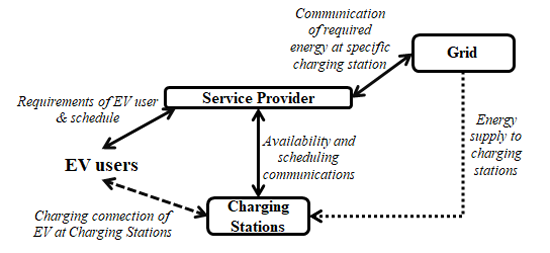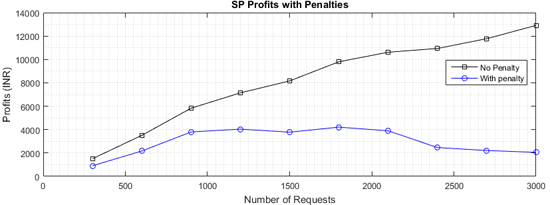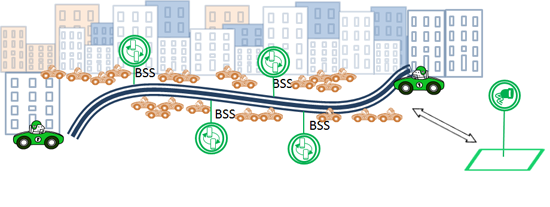Electric Vehicle Charging Management – Battery Charging vs. Swapping in Densely Populated Environments
By Vishu Gupta, Rajesh Kumar & BK Panigrahi
With limitations on fossil fuels and increase in the amount of released emissions, the transportation sector is being redesigned. The use of Electric Vehicles (EV) instead of harmful emission releasing Internal Combustion Engine vehicles (ICEV) proposes to not only solve the problem of accessibility and affordability of expensive fossil fuels but also helps with the reduction in the emissions from the growing number of vehicles. A number of countries across the globe have targets set out for electrification of transportation and hope to replace a certain percentage, if not all, of their ICEVs. This is a challenge, especially in densely populated countries such as India where the number of registered vehicles currently exceeds 200 million.
One of the major challenges that electric transportation has faced is range anxiety. The lack of easy availability of charging facilities when needed most is the main contributor to this. An additional challenge is that EVs require a significant amount of time to recharge, where even fast charging requires between 30-45 minutes. In order to combat the associated range anxiety, appropriate charging facilities have to be introduced into the existing transportation and power network. Charging station placement is therefore an important aspect of planning for EVs, closely followed by appropriate management at these EV charging stations (EVCS). For both, the power grid, the transportation network, the population density and EV demand play an important role. Here, let us assume that a network of EVCS exists and the challenge is now to manage the charging of the EVs at the EVCS.
The key entities involved in charging management include the service provider (SP), the grid and the EV driver. With the help of multiple charging/swapping locations, the SP is able to manage the recharging of the EVs while maximizing its own profit and attempting to minimize the burden on the grid. The scheduling occurs with communication and energy flow between these three entities (Figure 1).

Figure 1: Communication and Energy Flow (solid line – communication)
The three entities each add certain limitations to the problem of charging management. Firstly, the EV driver has certain requirements based on which it would like to recharge. Inclusion of consumer behaviour is important to charging management as it determines the possible timing and location of where the EV may be scheduled for recharging. A majority of people refuel their ICEV while they are travelling from one place to another. For weekdays, this time of travel coincides with the EV drivers’ office hours. As part of our research, we had conducted a survey and asked for the general departure times in the weekday mornings and evenings (A survey done as part of research work at Department of Electrical Engineering, Malaviya National Institute of Technology (MNIT) Jaipur, India). From this survey, the peak hours of travel were found to be between 8am – 10:30am and 6pm-8pm, as shown in Figure 2.

Figure 2: Travel Pattern of commuters in 24 hours
Assuming the same pattern for EV drivers and their desire to recharge on their way to a particular destination, we find that the maximum number of recharging requests would be around peak hours. The SP manages the scheduling at n EVCS in such a manner that a maximum number of EVs are able to be scheduled. It is to note that the Figure 2 provides the time of departure and the time of arrival at the EVCS would be delayed by a short period, resulting in a shift of the peaks. When considering a situation with limited EV penetration (p%) in a low population density area, the situation seems manageable with n EVCS. However, as the penetration increases, or we consider the same penetration in a densely populated area, a larger number of EVs may be requesting the same time and location for recharging. This poses a problem as the requirement of the user has to be met but the number of open times for charging are limited.

Figure 3: p% penetration in low population density – availability of charging options.
Figure 4: p% penetration of EVs in dense population > competing requests for charging times and locations.
As an example, over 1000 EVs, requiring charging time between 15-45 minutes were attempted to be scheduled. The scheduling is implemented based on 15 minute time slots. The hourly energy consumption and the slot wise energy consumption can be seen in Figure 5 and Figure 6. The bar graphs show the departure times from source of travel (right y-axis). Due to limitations of charging points at the requested time, few of the EVs remain unscheduled.

Figure 5: Hourly energy consumption

Figure 6: Slot wise Energy Consumption (Slot=15 minutes)
Considering the impact on the power grid, a higher penetration of EVs will add a higher load while recharging. Furthermore, the time of maximum requests coincides with the average peak load hours. The total load on the grid at any particular time will be:
LoadGrid = Base Load + EV Load
Looking at Figures 5 & 6, showcasing the energy consumption, it is clear that an excessive load will be introduced onto the grid at peak/ close to peak hours. Furthermore, as the EV penetration continues to increase, especially in areas with dense population, the scheduled load of the EVs will continue to increase. If such a load is to be added by the EVCS, then the number of EVCS that are considered in a densely populated area is limited.
Lastly, we consider the service provider. The main goal of the service provider is to schedule the maximum possible number of EVs such that its profit is maximized, where:
Profit = Revenue – Cost – Penalties
Here, Cost refers to the cost of purchasing energy from the grid. Different energy pricing approaches may be considered. Penalties refer to any discounts that may be offered to EV drivers in case they are not scheduled. The impact of a higher population is experienced when we explore the service provider profit for an increasing number of EV requests. After a point, the profits start to decline due to an increase in the number of unscheduled EVs (Figure 7).

Figure 7: Profits with no penalties and including penalties
A solution to this problem presents itself in terms of Battery Swapping Stations (BSS). Instead of charging the EV battery at the time the EV arrives at the station, the depleted battery (DB) is exchanged with a charged battery (CB). This on average takes less than 10 minutes, which is significantly less than the time required at the EVCS. This idea has been presented in IPWEA (Institute of Public Works Engineering Australasia) article, in May 2019. Furthermore, since the batteries may now be charged at a time convenient for both the grid and the service provider in terms of energy consumed and the cost of energy, battery swapping allows for more flexible management. The revenue of the service provider now involves a service fee. Another option with BSS is to charge the DBs at an offsite location where the grid load is more manageable, resulting in a lesser load at the location of the BSS.

Figure 8: BSS at same location as EVCS along with offsite charging for batteries
Even though battery swapping brings forth concerns of the quality of the swapped battery, overall, while comparing EVCS and BSS, we find that BSS offer more flexibility and convenience for all involved entities, especially when considering densely populated areas.
For a downloadable copy of October 2019 eNewsletter which includes this article, please visit the IEEE Smart Grid Resource Center.

Vishu Gupta received her Bachelor of Science in Electrical Engineering (BSEE) in 2009 from the University of Idaho, Moscow, Idaho, USA. She further obtained her Master of Science in Electrical Engineering (MSEE) from the University of Idaho, Moscow, Idaho, USA in 2012 respectively. She is currently pursuing her PhD in Electrical Engineering from Malaviya National Institute of Technology (MNIT), Jaipur, India in the fields Electric Vehicles in realistic scenarios, charging management and artificial intelligence techniques. Her research interests include development of intelligent applications for a smarter city and transportation electrification.

Rajesh Kumar (M'08 - SM'10) received the B.Tech. (Hons.) degree from the National Institute of Technology, Kurukshetra, India, in 1994, the M.E. (Hons.) degree from Malaviya National Institute of Technology (MNIT), Jaipur, India, in 1997, and the Ph.D. degree from the University of Rajasthan, India, in 2005. Since 1995, he has been a Faculty Member in the Department of Electrical Engineering, MNIT, Jaipur, where he is serving as a Professor. From 2009 to 2011, he was a Post Doctorate Research Fellow in the Department of Electrical and Computer Engineering, National University of Singapore (NUS), Singapore. His research interests include theory and practice of intelligent systems, computational intelligence and applications to power system, electrical machines and drives.

BK Panigrahi (SM'06) received the Ph.D. degree in power system from Sambalpur University, Sambalpur, India, in 2004. He is currently Professor with the Department of Electrical Engineering, Indian Institute of Technology (IIT), New Delhi, India. Prior to joining IIT, he was a Lecturer with the University College of Engineering, Sambalpur, India, for 13 years. His research interests include intelligent control of flexible ac transmission system devices, digital signal processing, power quality assessment, and application of soft computing techniques to power system.
To have the Bulletin delivered monthly to your inbox, join the IEEE Smart Grid Community.
Past Issues
To view archived articles, and issues, which deliver rich insight into the forces shaping the future of the smart grid. Older Bulletins (formerly eNewsletter) can be found here. To download full issues, visit the publications section of the IEEE Smart Grid Resource Center.





